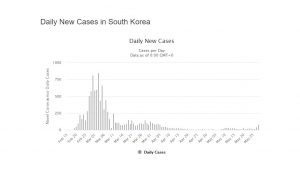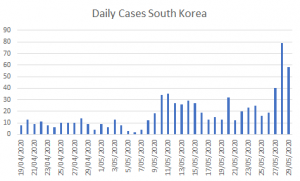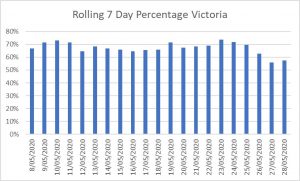What Might the Next 12-18 Months in Australia Bring?
Last week I presented via a pre-recorded video to the National Australia Bank Professional Development Day for mortgage brokers on what might happen with the Pandemic in Australia over the next 12-18 months.
Before I talk about what I told them I would like to tell two stories that illustrate the essence of one of the factors that I think will influence the next few months in particular. Last week I had to go to a client workplace for the first time in nearly three months. When I arrived, one of the staff members leapt up to greet me and went to shake my hand. I rapidly backpedalled and refused to shake hands. I then spent some time in their presence. That night at 10.20 pm I got a message to ring the client urgently. When I called, they said that staff member’s husband was in hospital with flu-like symptoms and shortness of breath and both of them were in isolation until the test results came back. Luckily the test was negative.
Later in the week, I was on a web conference about a regional tourism project I have been working on to help regions that have had the double impact of bushfires and COVID-19. One of the people on the hook up said that he had rung around a few booking agents in preparation for the meeting. He reported that they all said the phones were running hot and could not find enough accommodation for the long weekend and the school holidays that are coming up. He then said that maybe we do not need the project anymore. More on that at the end of this post.
My reason for telling those stories is that I think people have become too complacent about what might happen in the next few months. This post is to work through why I think that and why it could spark trouble.
As of May 31st, 2020, there have been 7193 confirmed cases in Australia
This represents 0.0279% of the population. To put this another way, this means that 99.97% of the people have no immunity.
There are definitely more cases than have been confirmed. Given the extensive testing that has been going on that it is unlikely that there are a huge number of unconfirmed cases. Even if we are generous and assume that there are ten times as many actual cases than confirmed cases that still leaves 99.721% without immunity (257,000 people is 1% of the population).
This means that in epidemiological terms, we are not materially different from none of us having immunity. But compared to 6 months ago when that was actually the case, we have virus circulating in the community.
Now, this is not an argument against relaxing some restrictions. The government policy has been to dampen down virus levels long enough for us to prepare for the next phase. That next phase is the capacity to open up our community and economy with enough testing and contact tracing in place to be able to jump on any cases as they emerge.
The problem is that opening up restrictions puts more people in contact with each other. If we are complacent about the risks, then we will have more people in contact with each other and in ways that increase the transmission of the virus. That means individual cases can become large clusters and multiple clusters very quickly.
We have much information about what this might mean in practice. For example, in South Korea, they had high numbers of cases initially and were able to dampen down that outbreak fairly quickly as shown in the following graphic:

Source: https://www.worldometers.info/coronavirus/country/south-korea/
But if you look closely, you can see that cases started rising again in May. If we zoom in on this period, we can see this more clearly:

Data source: https://www.cdc.go.kr/board/board.es?mid=a30402000000&bid=0030
It appears that most of the rise in cases may have arisen from just one person frequenting several night club venues in central Seoul with subsequent spread to a distribution centre leading to the higher case numbers later in May.
We have seen other examples in Australia, including the Cedar Meats cluster here in Victoria.
My Biases
When writing about these things, it is essential to highlight individual biases. Mine are:
- Both my parents are in their eighties and have pre-existing conditions, so I am highly attuned to the risks that they face.
- In my thirties and early forties, I had two separate unexplained incidents that partially paralysed each of my arms. The most likely cause was immune system reactions to a viral infection. Given that overactive immune responses to COVID-19 appear to be a key part of the seriousness of the disease in an individual, I am more attuned to risks than many people. I was warned after the incidents to minimise my chance of getting viral infections.
- Both my partner and I have successfully worked from home for over ten years, so we are well equipped to deal with the lockdown that has occurred.
- We have two older teenage children at home who mostly look after themselves, so we have not had to deal with the frustration of home-schooling younger children.
- I am well aware that Victoria (and mainly Melbourne where we live) is the main area for cases in Australia in the last few weeks. The following graph, which shows the cases in Victoria as a percentage of total national cases on a 7-day rolling average basis clearly demonstrates this:

Data source: https://www.abc.net.au/news/2020-03-17/coronavirus-cases-data-reveals-how-covid-19-spreads-in-australia/12060704?nw=0
Given we have only 25% of the Australian population, this is mildly alarming.
So I am personally more at risk than the average person, I have family members who are in a very high-risk category, Victoria is a more risky place to be, and I have fewer frustrations in a lockdown than the average person.
As well as this, I have veterinary training and experience in preparing for and dealing with exotic and non-exotic disease outbreaks in animal populations, as well as a research degree in diagnostic testing for disease. Combined with my training and experience as a futurist, this means I am better able to understand what might happen than the average person.
The combination of all of these factors make me more cautious about moving to the next phase.
So, What Might Happen?
Futurists should not predict the future; they should show people possibilities that help them think about what they should do.
On the basis of what I have outlined earlier in this post, I think the most likely scenario is one of ongoing clusters of infection and wider outbreaks as we increase the number and range of interactions between people. This will be exacerbated by complacency in the general population. If cases stay low for a number of weeks, it is my view that this increases the risk in the medium term as it is exhausting for people to maintain hygiene and social distancing measures in the face of a threat that does not seem to be materialising.
There are particular risks in regional areas what have experienced little or no disease to date but may get an influx of visitors as restrictions on travel are reduced.
The government response will be to jump on these outbreaks as quickly as possible through testing and contact tracing and some level of shutdown, depending on the scale of the problem. This becomes harder the more interactions there are between people, but I am confident that we can achieve this and not end up experiencing some of the terrible situations in other countries.
The shutdown responses may include:
- Shutdowns of individual businesses, organisations and schools as we have already been experiencing.
- Wider shutdowns of areas or building types as we have seen in the closure of nightclubs in South Korea.
- Wider regional restriction or even imposition/reimposition of state barriers to movement if things start to get out of hand.
What Does this Imply?
This future implies several things:
- People should maintain social distancing and hygiene as much as they possibly can, especially those that are at high risk if they get infected.
- People should get tested if they have any concerns at all about signs of illness or who they may have come in contact with. This will enable early response if there is a problem. This is important for the individual but also improves the public health response.
- Businesses, and not for profit organisations need to be prepared for the risk that they will be shut down again for shorter or longer periods in response to problems in their area.
A Story about Thinking About the Future
I advise people that the best way to think about these things is in multiple pictures or scenarios about the future.
The regional tourism project I spoke about at the beginning of this post is about getting forward cashflow from future sales into businesses that have been hard hit so they can survive the next few months. It also is about giving tourists the confidence that they can commit to travelling.
The response from our meeting last week was that the phones are running hot now and maybe we do not have to worry about this. My reply to that view was that I think there are three basic forward pictures:
- That everything goes back to something like normal, and businesses do not need cashflow to be pulled forward.
- That an outbreak in your region might cause a shutdown of your tourism sector. This may also cause a lack of confidence in travelling to your region in the future.
- That the government starts to heavily subsidise tourism areas that have been hit hard by the lack of international travellers (this region is 99% domestic tourism-based) and this lures tourists away from your region.
I said to the group that I hope that scenario one comes true and that things go well, but hope is not a strategy. In all three of the scenarios, the tourism business and the general community will be better off if there is increased income from people prepaying part of future travel plans now.
This is how you should think. What are the possible future scenarios, and what strategy works in all or most of them? Being fixated on a single view of the future world looks great when it comes off but looks terrible when it doesn’t.
In a world where uncertainty and volatility are increased the chances of your single view of the future coming true are reduced. Think and plan accordingly.
Please stay safe out there, for yourself, and for the rest of the community.
Paul Higgins
June 1st 2020

